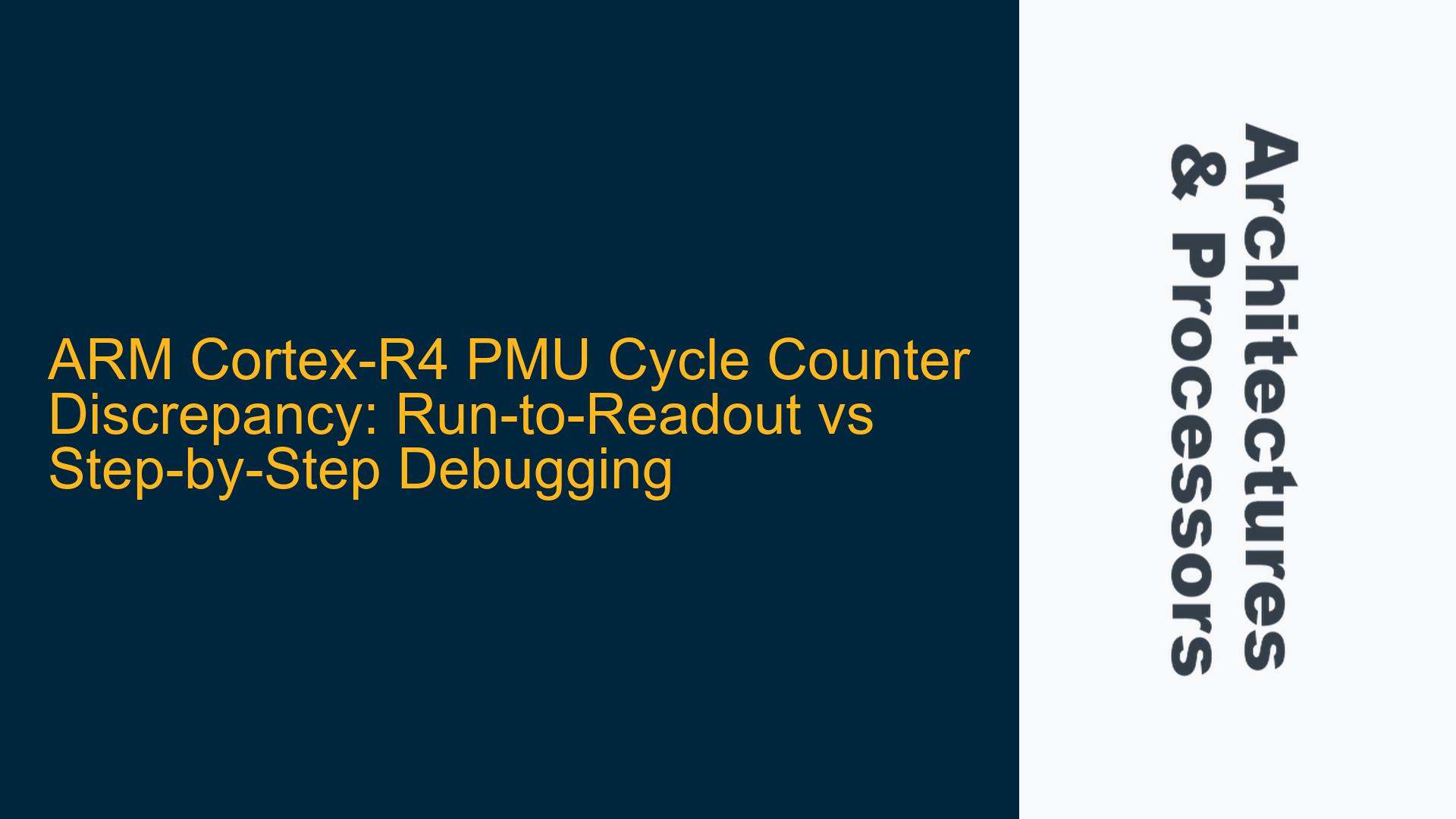Cortex-R4 PMU Cycle Counter Behavior During Run-to-Readout vs Step-by-Step Execution
The Cortex-R4 Performance Monitoring Unit (PMU) cycle counter is a critical tool for measuring the number of CPU cycles elapsed during code execution. However, discrepancies in cycle counter values between run-to-readout and step-by-step debugging scenarios can lead to confusion and misinterpretation of system performance. In this case, the cycle counter reports significantly higher values when the system is allowed to run freely compared to when it is stepped through instruction-by-instruction. This discrepancy suggests that the cycle counter is influenced by external factors such as interrupts, peripheral self-tests, and busy-wait loops that are not fully accounted for during step-by-step debugging.
The Cortex-R4 PMU cycle counter operates by incrementing on every CPU cycle, providing a high-resolution measurement of execution time. When initialized early in the startup sequence, after PLLs are locked and the CPU clock is stable, the cycle counter should accurately reflect the time taken for the system to reach a specific point in the code, such as the main() function. However, the observed behavior indicates that the cycle counter values diverge significantly depending on whether the system is allowed to run freely or is stepped through manually. This divergence points to underlying hardware-software interactions that are not immediately apparent during step-by-step debugging.
The key observation is that the cycle counter value is approximately 15 times higher during run-to-readout compared to step-by-step execution. This suggests that significant CPU cycles are being consumed by activities that are either bypassed or minimized during step-by-step debugging. These activities could include peripheral self-tests, memory initialization routines, or interrupt handling that are not fully accounted for when stepping through the code manually. Understanding the root cause of this discrepancy requires a detailed analysis of the system’s initialization sequence, interrupt configuration, and peripheral self-test routines.
Interrupts, Peripheral Self-Tests, and Busy-Wait Loops Impacting Cycle Counter Accuracy
The discrepancy in cycle counter values between run-to-readout and step-by-step execution can be attributed to several factors, including interrupt handling, peripheral self-tests, and busy-wait loops. Each of these factors can significantly impact the cycle counter’s accuracy, depending on the execution mode.
Interrupt Handling
During step-by-step debugging, the debugger typically disables interrupts to maintain control over the execution flow. This means that any interrupt service routines (ISRs) that would normally execute during run-to-readout are effectively bypassed during step-by-step debugging. If interrupts are enabled during the initialization sequence, they could contribute to the higher cycle count observed during run-to-readout. Even if interrupts are intended to be enabled only after main(), there may be unintended or spurious interrupts that are triggered during the startup sequence.
Peripheral Self-Tests
Many embedded systems perform self-tests on peripherals such as memory controllers, communication interfaces, and diagnostic modules during startup. These self-tests often involve busy-wait loops, where the CPU repeatedly polls a status register until a specific condition is met. During step-by-step debugging, these busy-wait loops may appear to complete almost instantly, as the debugger steps over the polling instructions without waiting for the actual condition to be satisfied. In contrast, during run-to-readout, the CPU spends a significant number of cycles waiting for these conditions to be met, leading to a higher cycle count.
Busy-Wait Loops
Busy-wait loops are a common source of cycle count discrepancies. These loops are often used in low-level initialization code to wait for hardware states to stabilize or for peripheral operations to complete. During step-by-step debugging, the debugger may step over these loops without fully executing them, resulting in an artificially low cycle count. During run-to-readout, however, the CPU spends the full number of cycles required to complete these loops, leading to a higher cycle count.
Cache and Memory Initialization
The Cortex-R4 processor may also perform cache and memory initialization during startup, which can consume a significant number of cycles. During step-by-step debugging, these initialization routines may appear to complete faster than they actually do, as the debugger may not fully account for the time spent waiting for cache lines to be filled or memory controllers to be configured. During run-to-readout, these routines are fully executed, leading to a higher cycle count.
Mitigating Cycle Counter Discrepancies: Strategies for Accurate Cycle Counting and Boot Time Optimization
To address the discrepancy in cycle counter values and optimize boot time, several strategies can be employed. These strategies focus on accurately measuring cycle counts, minimizing unnecessary cycle consumption, and optimizing the initialization sequence.
Accurate Cycle Counting
To ensure accurate cycle counting, it is essential to account for all factors that contribute to cycle consumption during the initialization sequence. This includes enabling and disabling interrupts at the appropriate times, minimizing the use of busy-wait loops, and carefully managing peripheral self-tests. One approach is to use the PMU’s event counters to track specific events, such as cache misses or branch mispredictions, that may contribute to cycle count discrepancies. By correlating these events with the cycle counter, it is possible to identify and address the root causes of cycle count discrepancies.
Interrupt Management
Interrupts should be carefully managed during the initialization sequence to avoid unintended cycle consumption. This includes ensuring that interrupts are disabled until all necessary initialization routines are complete and that any spurious interrupts are handled appropriately. If interrupts are required during initialization, their impact on the cycle counter should be carefully measured and accounted for.
Optimizing Peripheral Self-Tests
Peripheral self-tests should be optimized to minimize their impact on boot time. This includes reducing the number of busy-wait loops and using hardware features, such as DMA or interrupt-driven I/O, to offload tasks from the CPU. Additionally, self-tests should be designed to complete as quickly as possible, without compromising the integrity of the tests.
Reducing Busy-Wait Loops
Busy-wait loops should be minimized or eliminated wherever possible. This can be achieved by using hardware features, such as timers or interrupt-driven I/O, to wait for specific conditions to be met. Alternatively, busy-wait loops can be replaced with more efficient polling mechanisms, such as using the PMU’s event counters to track the number of cycles spent waiting for a condition to be met.
Cache and Memory Initialization Optimization
Cache and memory initialization routines should be optimized to minimize their impact on boot time. This includes using hardware features, such as prefetching or burst transfers, to speed up memory initialization. Additionally, cache initialization routines should be designed to complete as quickly as possible, without compromising the integrity of the cache.
Boot Time Optimization
To achieve a boot time of under 10 ms, it is essential to carefully analyze and optimize the entire initialization sequence. This includes identifying and eliminating unnecessary cycle consumption, optimizing peripheral self-tests, and minimizing the use of busy-wait loops. Additionally, the use of hardware features, such as DMA or interrupt-driven I/O, can help offload tasks from the CPU and reduce boot time.
Practical Example: Cycle Counter Debugging and Optimization
Consider a scenario where the Cortex-R4 processor is initializing a memory controller during startup. The initialization sequence includes a busy-wait loop that polls a status register until the memory controller is ready. During step-by-step debugging, this loop appears to complete almost instantly, as the debugger steps over the polling instructions without waiting for the actual condition to be satisfied. However, during run-to-readout, the CPU spends a significant number of cycles waiting for the memory controller to be ready, leading to a higher cycle count.
To address this issue, the busy-wait loop can be replaced with a more efficient polling mechanism, such as using the PMU’s event counters to track the number of cycles spent waiting for the memory controller to be ready. Additionally, the memory controller initialization routine can be optimized to reduce the number of cycles required to complete the initialization.
Conclusion
The discrepancy in cycle counter values between run-to-readout and step-by-step execution is a common issue in embedded systems, particularly during the initialization sequence. By carefully analyzing and optimizing the initialization sequence, it is possible to achieve accurate cycle counting and reduce boot time. This includes managing interrupts, optimizing peripheral self-tests, minimizing busy-wait loops, and optimizing cache and memory initialization routines. By employing these strategies, it is possible to achieve a boot time of under 10 ms and ensure accurate cycle counting during system initialization.
This detailed analysis and troubleshooting guide provides a comprehensive approach to addressing cycle counter discrepancies and optimizing boot time in Cortex-R4-based systems. By following these strategies, developers can ensure accurate cycle counting and achieve optimal system performance.






